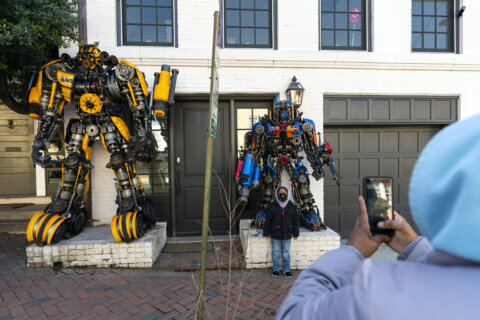WASHINGTON — In one week, WTOP’s news operation will be running from its brand-new Glass-Enclosed Nerve Center. And while we’re excited about the move to Friendship Heights, it also will mean a bittersweet goodbye to the Idaho Avenue studio that’s been our home for 30 years in Northwest D.C.
This week we’re looking back on some of the memories we’ve made in this newsroom — some fun, some serious.
In 1989, when WTOP moved in, the only way you could hear our news was on the radio. Now, three decades later you can hear our voices on your computer, your phone and on Alexa.
Regardless of the delivery method, news stories have to be written. After the editor creates the lineup for the next hour, our writer and other anchors turn the stories into scripts, always on deadline.
Each story was printed on a separate piece of paper, and assembled into a script — one for each anchor.
In many cases, anchors don’t get a chance to pre-read the script that’s handed to them. Scripts are important.
Early on during our time here, scripts were written on Newsstar — a custom-build system, that made it infuriatingly easy to delete your entire script and in some cases an entire half-hour of news with a single keystroke.
While the fussy system was eventually replaced with far more user-friendly ones, computer crashes and system failures are inevitable, even today. But in a 24-hour news station, we don’t have the luxury of saying, “We’ll be back a little later.”
Over the years, when our script-writing systems have crashed, we’ve had to come up with Plan Bs, while the clock kept ticking.
“Sometimes we would literally be fishing paper out of the trash cans and reassembling our lineups, so that the anchors had something to read,” said Colleen Kelleher, who started at WTOP as a writer/editor, and is now the Senior Digital Editor.
She remembered the time it was clear the computer system would be down for quite a while, so the newsroom went fishing for IBM Selectric typewriters that had been moved out of sight a few years earlier.
“They were in a supply closet, stacked one on top of each other,” said Kelleher. “We carried them out — they weighed about 25 pounds each.”:
“Some were manual,” recalled Midday Editor Mike Jakaitis, who started in 1997, as an assistant editor.
In later years, when the station’s script writing system was down, but wtop.com was online, we jury-rigged other ways to get scripts to the anchors.
“We were copying and pasting things from the website into Microsoft Word, and and printing stories out that way,” said Jakaitis.
Since anchors in the studio are reliant upon having stories to read, Jakaitis and other editors said they try to portray calm, even when technology isn’t cooperating.
“You tell your anchors, ‘Everything’s fine. We got it,'” said Jakaitis. “Meanwhile, your heart is going a hundred beats a second.”
Even with brand new, state of the art equipment waiting at WTOP’s new newsroom, Jakaitis knows there will be times when the team will have to scramble to get a script ready for air.
“Everyone comes together, to help each other out — it’s a good bonding moment,” said Jakaitis. “At the time it sucks, but afterward, it’s a pretty good feeling.”







